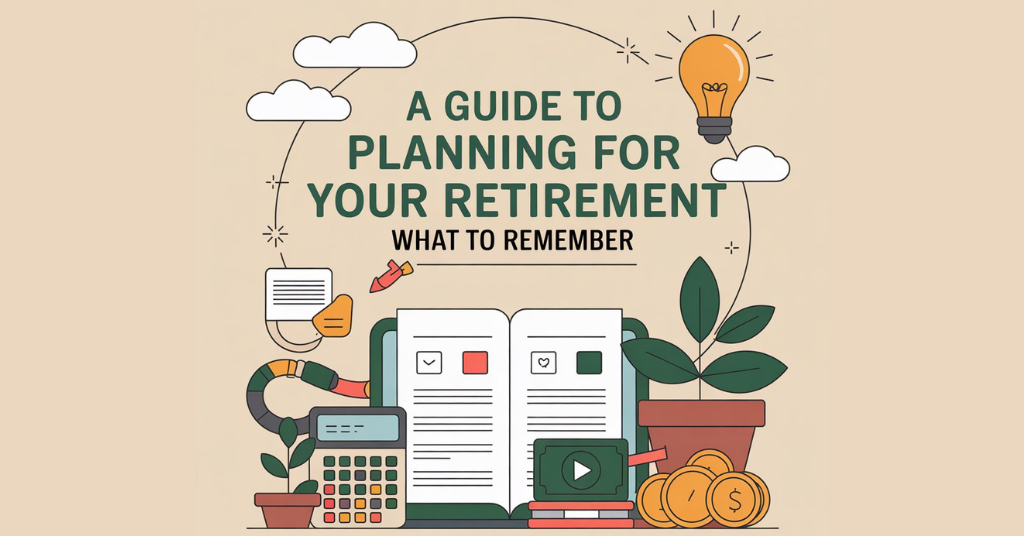When you retire, your life changes — and so does your superannuation (super). For years, your super has been growing quietly in the background, collecting employer contributions and investment earnings. But once you retire, this money becomes your key source of income.
In this blog, we’ll explain what happens to your super when you retire in Australia, including withdrawal options, taxes, age rules, examples, and practical tips to help you make the most of your super savings.
🌅 What Happens to Your Super When You Retire?
When you retire, several things happen to your super:
- Your employer stops contributing because you’ve stopped working.
- You can access your super if you meet the conditions of release (like reaching your preservation age and retiring).
- You can decide how to use your super — take it as a lump sum, start a retirement income stream, or do a combination of both.
- You can choose to keep your super invested in a pension account to earn more returns.
- Some insurance policies in your super (like life or income protection) might end when you retire.
So, your super doesn’t just “stop.” It becomes your main retirement fund — and you choose how to use it.
🎯 When Can You Access Your Super?
You can only access your super once you meet a “condition of release.” The most common condition is retirement after reaching your preservation age.
🧭 Preservation Age Table (Australia)
| Date of Birth | Preservation Age |
| Before 1 July 1960 | 55 |
| 1 July 1960 – 30 June 1961 | 56 |
| 1 July 1961 – 30 June 1962 | 57 |
| 1 July 1962 – 30 June 1963 | 58 |
| 1 July 1963 – 30 June 1964 | 59 |
| After 1 July 1964 | 60 |
Once you reach age 65, you can access your super without restrictions, even if you still work part-time.
🔄 Options for Your Super After Retirement
Once you’re eligible, you can use your super in three main ways:
🟩 Option 1: Take a Lump Sum
You can withdraw part or all of your super in one go as a lump sum.
This might be useful if you want to:
- Pay off a mortgage or debts
- Renovate your home
- Help your children or grandchildren financially
- Buy a new car or travel
Example:
Let’s say you retire at 65 with $300,000 in your super account.
If you withdraw the entire amount as a lump sum, you’ll get $300,000 tax-free (because you’re over 60 and in a taxed super fund).
But remember — once it’s withdrawn, that money is no longer invested in super, meaning it won’t grow or earn tax-free returns.
Tip: Don’t rush to take all your super at once unless you have a plan for how to manage it safely.
🟨 Option 2: Start an Income Stream (Account-Based Pension)
This is the most common choice among Australian retirees.
You convert your super into a retirement income stream that pays you regular income — monthly, quarterly, or yearly.
Your money stays invested, and you get both income and investment growth.
Benefits:
- You receive a steady income for living expenses.
- Earnings inside the pension account are tax-free.
- Withdrawals are tax-free if you are aged 60 or over.
Minimum Drawdown Rules:
The Australian Government requires you to withdraw at least a minimum percentage of your balance each year.
| Age | Minimum Drawdown Rate |
| Under 65 | 4% |
| 65–74 | 5% |
| 75–79 | 6% |
| 80–84 | 7% |
| 85–89 | 9% |
| 90–94 | 11% |
| 95+ | 14% |
Example Calculation:
If you are 67 years old and have $400,000 in your super,
your minimum annual withdrawal = 5% × $400,000 = $20,000 per year.
That means you must take at least $20,000 as income during the financial year, but you can take more if needed.
🟦 Option 3: Combine Lump Sum and Income Stream
Many retirees use a mix of both.
For example, take a lump sum to pay off your mortgage, and convert the rest into a pension for regular income.
Example:
Mary retires at 62 with $500,000 in super.
She uses $100,000 to clear her home loan and converts $400,000 into an income stream.
Her minimum drawdown (5%) = $20,000 per year.
She enjoys both — a debt-free home and stable yearly income.
💰 Tax on Your Super After Retirement
One of the best parts about retiring in Australia is the tax benefits on super withdrawals.
Let’s break it down:
✅ If You’re 60 or Older
- Lump sum withdrawals: Tax-free (if your super is from a taxed fund).
- Income stream payments: Tax-free.
- Investment earnings inside pension account: Tax-free.
Example:
Tom is 65 and withdraws $250,000 from his taxed super fund.
He pays $0 in tax — the entire amount is tax-free.
⚠️ If You’re Under 60 (but above preservation age)
Some tax may apply.
Your withdrawal will have two parts — tax-free and taxable.
- The tax-free component (usually your personal contributions) is always tax-free.
- The taxable component is taxed at your marginal rate, but you get a 15% tax offset.
Example:
Sophie retires at 58 and withdraws $200,000.
Her fund tells her that $50,000 is tax-free and $150,000 is taxable.
She gets a 15% tax offset on the taxable part.
If her tax rate is 32.5%, her effective tax rate becomes 17.5% on the taxable amount.
Tax Payable:
= $150,000 × 17.5% = $26,250
Her after-tax amount = $200,000 − $26,250 = $173,750.
🚫 If You’re Below Preservation Age
Withdrawals are taxed at 22% (including Medicare levy) or your marginal rate, whichever is lower.
This discourages early access before retirement.
📊 Example: Comparing Super Options
| Scenario | Lump Sum | Income Stream | Mixed Option |
| Super Balance | $400,000 | $400,000 | $400,000 |
| Access | All at once | Regular monthly payments | Partial lump sum + regular income |
| Tax (Age 65) | $0 | $0 | $0 |
| Pros | Full control, pay off debts | Regular income, keeps growing | Balanced flexibility |
| Cons | No growth, spend risk | Investment risk | Slightly complex setup |
Example Summary:
If you take all as a lump sum, you might spend it too quickly.
If you keep it as a pension, your money stays invested, but returns depend on markets.
The combined option offers flexibility and security.
🧾 How Much Tax-Free Super Can You Move to Pension Phase?
The Australian Government sets a Transfer Balance Cap.
It limits how much of your super you can move into a tax-free retirement account.
As of 2025, the transfer balance cap is $2.0 million.
That means you can transfer up to $2 million of your super into the pension phase, where investment earnings are tax-free.
Any extra must remain in your accumulation account, where earnings are taxed at 15%.
Example:
If you have $2.5 million,
you can move $2 million to your pension account and keep $500,000 in accumulation phase.
That $500,000 will still earn returns, but those earnings will be taxed at 15%.
💡 What If You Keep Working After Retirement Age?
If you retire at 60 but decide to work part-time, you can still contribute to super.
You Can
- Make voluntary contributions (before-tax or after-tax)
- Use the Downsizer Contribution (up to $300,000 from selling your home if you’re 55+)
- Reinvest income from part-time work
You Cannot
- Access new contributions made after you “retire” until another condition of release is met.
Example:
John retires at 61 but starts part-time consulting.
He contributes $10,000/year to his super until 67.
These contributions help his balance grow and provide more tax-free retirement income later.
🧮 How Super Can Grow Even After Retirement
Even after you start an income stream, your super remains invested.
That means it can still grow through investment returns.
Example:
Lisa has $500,000 in her pension account.
Her fund earns 6% return per year, and she withdraws $25,000 annually.
Year 1 Calculation:
- Investment earnings: $500,000 × 6% = $30,000
- Withdrawal: $25,000
- New balance = $500,000 + $30,000 − $25,000 = $505,000
So even after withdrawing income, her balance increases slightly — showing how staying invested can help super last longer.
💸 How Your Super Affects the Age Pension
Your super balance may affect your Centrelink Age Pension payments because it’s counted in the assets and income test.
- If you withdraw large lump sums, those funds may count as financial assets (reducing your pension).
- If you keep super as an income stream, only part of it may be assessed for Centrelink purposes.
Example:
A couple with $700,000 in super might get a reduced Age Pension compared to a couple with $300,000, depending on other assets and income.
It’s important to plan withdrawals carefully so you don’t lose government benefits unnecessarily.
🧠 Smart Tips to Manage Super After Retirement
- Don’t withdraw everything at once — it might affect your future income and pension eligibility.
- Keep some super in an income stream to enjoy tax-free earnings.
- Plan withdrawals carefully — only take what you need.
- Check your insurance inside super — it may end when you retire.
- Update your beneficiaries — to ensure your loved ones receive your super after your death.
- Review your investment strategy every few years — your goals change as you age.
- Use a financial adviser or tax specialist — especially if your super is large or from multiple funds.
🔍 What Happens to Your Super When You Die?
If you pass away, your super is paid as a death benefit to your nominated beneficiaries.
If the beneficiary is a dependent (like a spouse or child under 18), they usually receive the payment tax-free.
If the beneficiary is non-dependent, tax may apply to the taxable component.
This is why keeping your beneficiary nomination updated with your super fund is essential.
🧭 Final Example Summary
Let’s bring everything together in a simple scenario:
- You retire at age 65 with $600,000 super.
- You move $500,000 into an account-based pension and withdraw $100,000 as a lump sum to pay debts.
- Your annual minimum pension (5%) = $25,000, which is tax-free.
- Your $500,000 pension balance grows by 5% (=$25,000) per year, offsetting your withdrawals.
- After a year, your balance remains around $500,000, showing how income streams can sustain your retirement for decades.
Also Read: A Retirees To Do List 6 Things to Plan Before Retiring
🌟 Conclusion: Make Your Super Work for You in Retirement
Your superannuation is your reward for years of hard work.
When you retire, you finally get to enjoy it — but making smart decisions is vital.
- Don’t rush into lump-sum withdrawals.
- Consider income streams for regular, tax-free payments.
- Keep your money growing while protecting your lifestyle.
- Check your eligibility for government pensions and benefits.
Every person’s situation is different, so it’s best to speak with your super fund or a licensed financial adviser to create a plan that fits your needs.
Your super can give you freedom, comfort, and peace of mind — if you manage it wisely.



